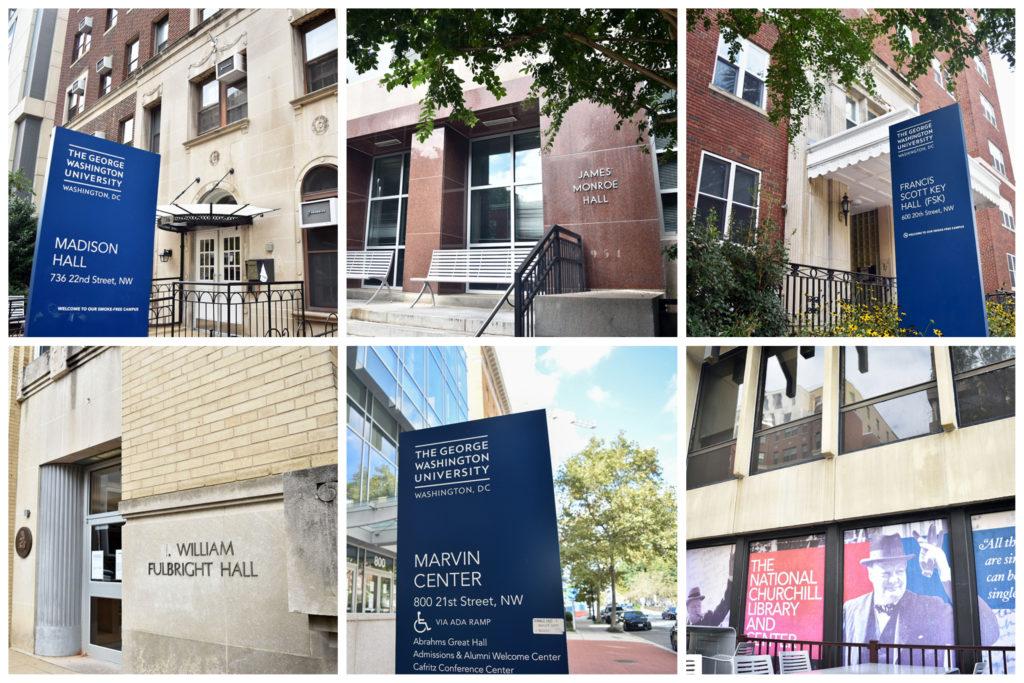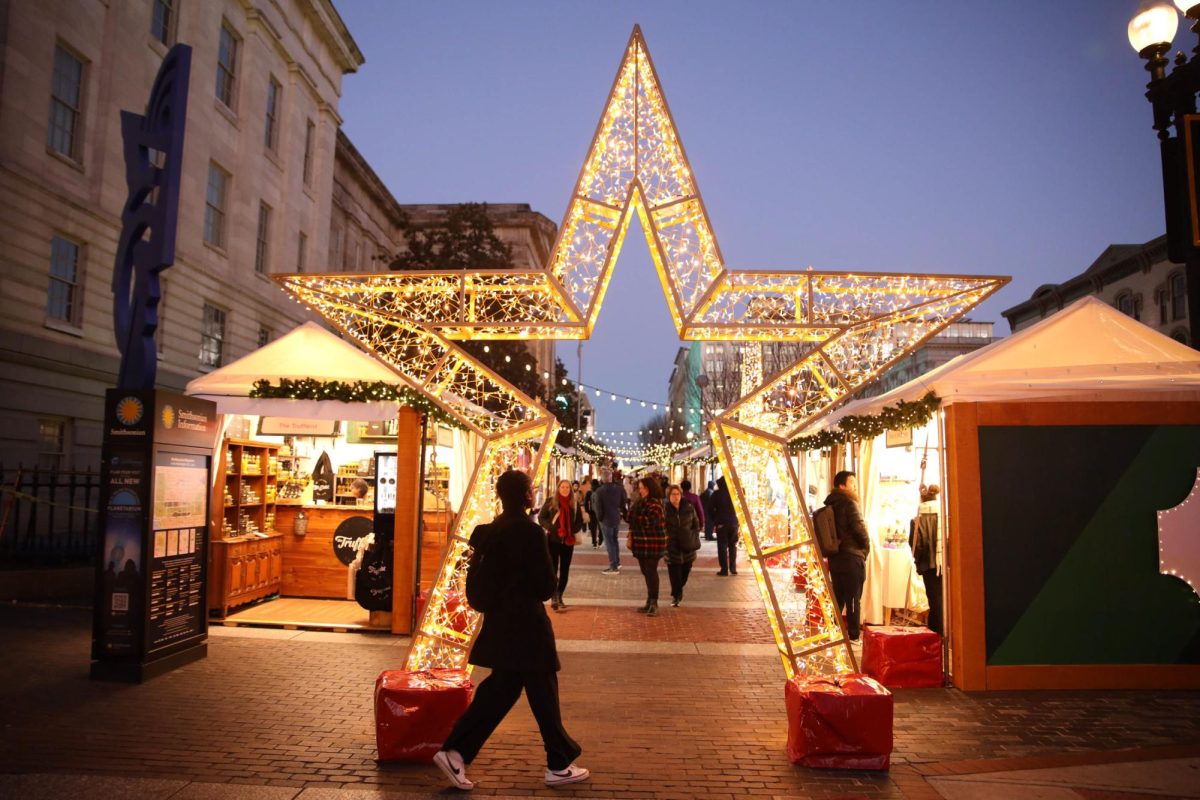As recent incidents of racial injustice continue to gain national attention, long-standing names and traditions are being brought into question – and GW is no exception.
In a 1967 press release, administrators said unnamed campus buildings should be named for people affiliated with the D.C. area or those “distinguished in American thought and culture.” But a coalition of five student groups is calling on the University to rethink the names of the Colonial moniker and six campus buildings named after prominent figures who, despite their contributions to the University and the United States, enslaved people or supported segregation.
“A lot of the times Black students have been asked to live, breathe and occupy spaces in buildings which are named after reprehensible men who promoted segregation in their time here at GW,” said Rayaan Ahmed, the director of advocacy for The Black Student Union – an organization involved with the campaign. “At the end of the day, Black students aren’t asking for a lot. We’re literally asking for the rooms that we sleep and eat in to not be named after individuals that claim our people.”
Students launched the campaign just a week after officials established task forces to evaluate these names, including that of the Marvin Center and the Colonial moniker. In the meantime, we sifted through Hatchet archives, GW Libraries’ pages and press releases to better understand each building’s namesake and why students are pushing for their name changes.
Cloyd Heck Marvin Center
Named: 1971
Named after: Former University President Cloyd Heck Marvin
Formerly known as the “University Center,” the Cloyd Heck Marvin Center opened its doors Feb. 16, 1970, but remained nameless for almost a year. Students informally dubbed the building “Kent State Memorial Center” on May 5, 1970, to honor the lives lost in the Kent State shooting – a massacre conducted by the Ohio National Guard on a group of students protesting the United States’ involvement in the Vietnam War.
Less than a year later on Feb. 15, 1971, the building was officially named the Cloyd Heck Marvin Center after former University President Cloyd Heck Marvin, who served from 1927 to 1959. Dorothy Betts Marvin, the late GW president’s wife, donated $1 million to the University to name the center for him two years after his death, according to Washingtonian.
Marvin is known for increasing the school’s endowment eightfold, tripling the faculty size and doubling enrollment during his tenure. But the name had never sat right with students. Since the year it was dedicated to Marvin, students have protested the building’s namesake, citing his segregationist attitudes.
During his presidency, Marvin resisted desegregating the University and restricted students’ freedom of speech. His anti-integration advocacy made the University the last in D.C. to integrate in 1954. When Hatchet staff members wrote an editorial in the spring of 1947 arguing that Black students should be admitted to the University, Marvin swiftly suspended them.
Marvin also defended his segregationist views, saying students learn best within their own racial groups.
“Students of any race or color perform their best educational disciplines when they are happily situated in a congenial and homogenous group, and the University, in its tradition and social environment, has long preserved this policy,” Marvin said in an unaddressed internal policy statement in 1938.
The Churchill Center
Named: 2016
Named after: Former British Prime Minister Winston Churchill
The Churchill Center opened Oct. 29, 2016, through a partnership between the University and The International Churchill Society, an organization dedicated to preserving former Prime Minister Winston Churchill’s legacy. Located in the basement of Gelman Library, The GW-founded center is the first major research center dedicated to the study of the former prime minister of the United Kingdom.
The society chose to partner with GW due to its proximity to the White House and its status as a world-renowned university, according to GW Libraries.
“Churchill’s leadership during the greatest crises of the 20th century [referring to WWII] provides inspiration and instruction to leaders in every field of endeavor,” a GW Libraries page states.
But Churchill was involved in overseeing concentration camps in Kenya and South American and orchestrated the Bengal Famine, during which a substantial portion of the rural population of British India died via starvation. Student groups that launched “Reconsider the Names” said those acts are grounds to change the center’s name.
Churchill has also been quoted conveying racist attitudes. For example, he denied the harmful effects of racism and asserted that Whites constituted a superior race.
“I do not admit for instance that a great wrong has been done to the Red Indians of America or the Black people of Australia,” Churchill said in a 1937 address to the Palestine Royal Commission. “I do not admit that a wrong has been done to these people by the fact that a stronger race, a higher-grade race, a more worldly wise race to put it that way, has come in and taken their place.”
Fulbright Hall
Named: 1996
Named after: Former U.S. Senator J. William Fulbright, D-Ark.
Fulbright Hall, originally known as the Everglades Apartments, was renamed in 1996 to honor the late J. William Fulbright, a Democratic senator from Arkansas and alumnus. The building earned the designation of a historic site by the National Parks Service in 2010.
Fulbright created the 1943 Fulbright Resolution, which prompted the United States to join the United Nations. A couple of years later, he proposed a bill to Congress calling for the sale of excess war property to fund international peace “through the exchange of students in the fields of education, culture and science.” For that reason, The Fulbright Program, an international exchange program funded by the U.S. government, was named after him.
Despite his contributions to U.S. foreign policy, Fulbright was a signatory of the Southern Manifesto, a document written in 1956 to oppose the landmark Supreme Court case Brown v. Board of Education and the racial integration of public spaces.
Francis Scott Key Hall
Named: 1940
Named after: Lawyer Francis Scott Key
FSK Hall was built in 1940 and named after Francis Scott Key, the songwriter of “The Star-Spangled Banner.” It’s unclear why the GW residence hall was named for him.
Key was an advocate of slavery and an enslaver himself. He served as the district attorney of D.C. for seven years and he used his position to defend slavery and attack the abolitionist movement, according to the Smithsonian Magazine.
“He spoke publicly of Africans in America as ‘a distinct and inferior race of people, which all experience proves to be the greatest evil that afflicts a community,’” journalist Jefferson Morley wrote in the 2012 book “Snow-Storm in August: Washington City, Francis Scott Key, and the Forgotten Race Riot of 1835.”
As a former DA, Key spent time trying to “crack down” the rhetoric and “free speech” of abolitionists in D.C. who he believed were “riling things up in the city,” Smithsonian Magazine wrote. At one point, Key prosecuted a doctor living in Georgetown for possessing abolitionist pamphlets. The case ended up going to the Supreme Court as United States v. Reuben Crandall, where Key tried to argue that property rights of slaveholders outweighed the free speech of abolitionists. He believed that abolitionists’ free speech rights were so dangerous that he tried to have Crandall hanged, according to Smithsonian Magazine.
Madison Hall
Named: 1957
Named after: Fourth U.S. President James Madison and first lady Dolley Madison
Madison Hall, originally known as the Flagler Apartments, was built in 1945 and acquired by GW in 1957. The University renamed the building for the fourth president, James Madison, and his wife, first lady Dolley Madison.
Madison is known as “The Father of the Constitution” for his role in drafting and ratifying the document. But students are calling for the University to reconsider this name because of Madison’s role as an enslaver – he owned a plantation in Virginia called Montpelier with more than 100 slaves in 1801. He viewed slavery as a necessary element of the Southern economy.
James Monroe Hall/Hall of Government
Named: 1951
Named after: Fifth U.S. President James Monroe
Monroe Hall/Hall of Government was built in 1951 and named after the fifth president of the United States, James Monroe, that year. The Founding Father’s triumphs include the Westward expansion of the United States and the creation of the Monroe Doctrine, which states that America would not interfere in wars between European powers and that Europe should stop colonization and expansion in the Western world.
Students leading the “Reconsider the Names” campaign said the hall’s namesake should change because of Monroe’s role as an enslaver and “his dehumanization of native people to uncivilized ‘savages,” according to the group’s initial petition. The Monroe Doctrine paved the way for the United States to further colonize occupied countries and expand its power and influence into regions where some say it never belonged.
“The Monroe Doctrine’s legacy is steeped in the blood and sweat of the Latin American people,” the Reconsider the Names petition states.
Colonial moniker
Established: 1926
Named after: George Washington
The University, originally called Columbian University, was renamed to The George Washington University in 1904 after the George Washington Memorial Association commissioned a campus building in honor of the first U.S. president. Officials adopted the Colonial moniker in the fall of 1926 as a way to pay homage to the school’s new namesake.
Prior to 1926, sports teams were called the “Crummen,” which was the last name of an old sports coach, “Buff and Blue” and the “Hatchetites.” A Hatchet editorial written on Oct. 27, 1926, advocated for GW to instead go by the “Colonials.”
“George Washington University, in its antecedents, is a colonial school,” the editorial states. “Dating back to very early post-Revolutionary days, it was founded when the term ‘colonial’ still applied to an era which was then passing. Let us then, in just regard for our precious heritage, adopt as the name for the warriors wearing the Buff and Blue the term ‘Colonials.”
But Phillip Troutman, the director of writing in disciplines and an assistant professor of writing and history, said the “Colonials” nickname was conceptualized by administrators “romanticizing a purportedly glorious golden age of patriarchal gentlemen and civilized ladies.”
“Adherents of the 20th century Colonial Revival idea routinely ignored and sometimes openly embraced the genocidal wars and violent enslavement inherent to the American colonizing project and to white colonists’ identity,” Troutman said in an email.
Troutman added that the term is not closely tied to George Washington, the person, or the Revolution.
“Washington led the Continental Army and disparaged the petty ‘Colonial’ ones,” Troutman said. “But the term is even more problematic today, especially for a university so well known for international affairs: when our study abroad programs instruct students not to pack any GW clothing with the term ‘Colonials’ on it, you know you need to change your ‘brand.’”
Clara Duhon contributed reporting.








